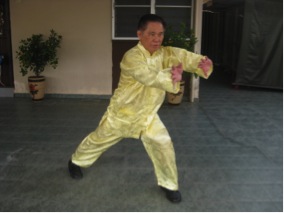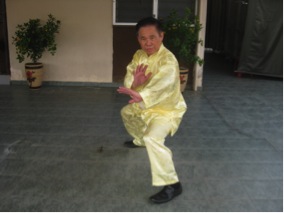HOOK-SPRING LEG

One could not know the secret of Hook-Spring Leg by merely looking at the form
One of the most memorable of the combat applications involved a close secret of “ngow than tui” (勾弹腿) in Cantonese pronunciation, or “hook-spring leg”, which was sometimes heard amongst the initiated but rarely understood. This was also said to be one of the secrets of the famous Southern Shaolin master, Wong Fei Hoong.
Years later, when I had a discussion on the famous “Tiger-Crane Set” with my siheng (elder kungfu brother) from Uncle Righteousness’ school, Chiew Shi Khern, who was nicknamed “Iron Arm”, he told me that he had sought far and wide for the application of “hook-spring leg” but to no avail. Siheng Chiew Shi Khern was the one who mentioned me to my first sifu, Uncle Righteousness, and who first taught me the fundamental stances. I am very grateful to him. So I volunteered to show him the secret of “hook-spring leg”. He was simply amazed at its subtlety and effectiveness.
On another occasion I had a discussion with another siheng from Uncle Righteousness’ school, Wong Choy Wah, who was famous for the Triple Stretch Set and was at the time the Grandmaster of Chin Wah Hoong Ka Kungfu Gymnasium, the kungfu school founded in honour of my sifu, Uncle Righteousness, whose real name was Lai Chin Wah. As usual, the discussion concluded with some friendly sparring.
My siheng got me in a chin-na grip using the pattern “Yun Than Tames Tiger” (Yun Than is the Warrior God of Wealth in Chinese beliefs). I can bet that most martial artists would be quite helpless in this situation. But I slid in and applied the “hook-spring leg”, and to his and my great surprise, my siheng instantly fell flat on his back.
It was a great surprise because my siheng was well-known for his solid stance. It was also a great embarrassment for me because while learning in Uncle righteousness’ school, it was my siheng who often taught me on behalf of my sifu.
“Let’s try again,” my siheng said. It was certainly not because my siheng was unhappy with my counter, but because he wanted to find out how “hook-spring leg” work. My siheng was modest and soft-spoken, despite his great attainment in kungfu. He is one of the few masters I have great respect for.
My siheng got me in the chin-na grip again using “Yun Than Tames Tiger”. I tried again to apply the “hook-spring leg”. But this time I could not move in. As I tried to move in, he pressed on my elbow, neutralising my movement.
I used the principle of instant change. Following his pressing momentum, which almost pressed me to the ground, I bent my elbow to neutralise his pressure and actually went onto the ground, and kicked up with my left foot at his groin, stopping just in time, using a pattern called “Naughty Monkey Kicks at Leaves”.
My siheng was again surprised, but he was happy. Smilingly, he said, “You have improved beyond recognition.”
“Tor che siheng seng yeong” (多谢师兄承让), which in Cantonese means “Thank you, siheng, for allowing me to make my move” (with the understood implication that he could stop the move had he wanted to).
“Tor che seng yeong” (多谢承让), which is “Thank you for allowing me to make the move” (but you could stop it had you wanted to) was the usual polite reply in the past after defeating an opponent, even in serious fights. Kungfu masters in the past, unlike many martial artists today who are out to humiliate their opponents, were courteous. When one wanted to challenge you, he would not growlingly say, “Let me show you how useless your martial art is”, but instead he would say, “Please, can you teach me a thing or two?” (请赐教一两招).
So, if you are a kungfu instructor and a person comes into your school and asks whether you can teach him a thing or two, it can mean that he is challenging you. But in today’s circumstances, 99% of the time it means he wants to be your student.

"Two Tigers Subdue Dragon" -- a pattern I often used in my younger days to counter Taikwondo kicks
You can read more stories at our Discussion Forum.
Please click here for details to order the special and limited edition. This edition will not be reprinted once it is sold out.
LINKS
